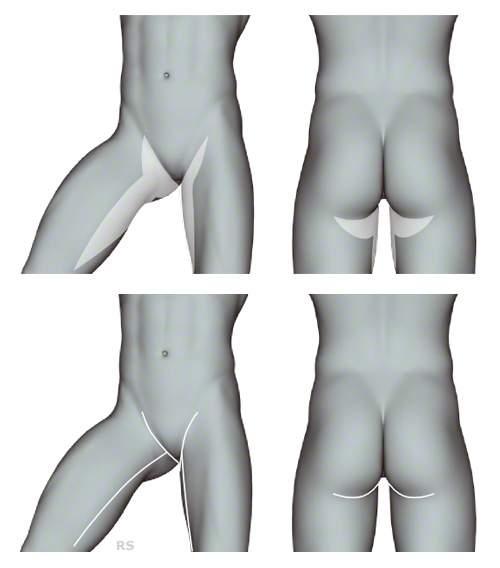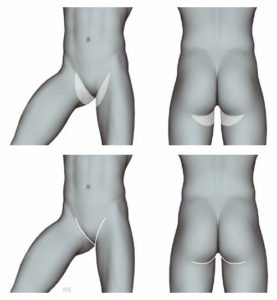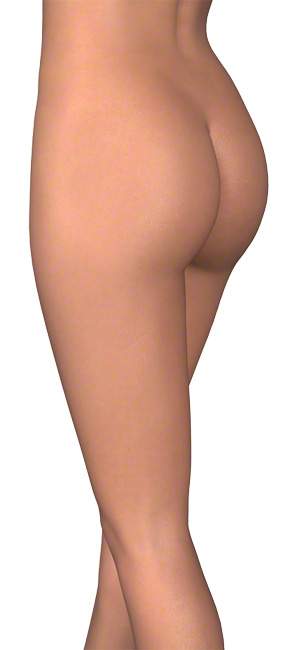A thigh lift is a procedure that is usually performed on patients at our Yuveo Clinic in Düsseldorf who have achieved significant weight loss.
The improved physical well-being is then often overshadowed by excess sagging skin(flabby skin) and residual fat deposits, particularly on the inner thighs.
However, people with pre-aged skin who are dissatisfied with the situation on their thighs often only see the possibility of improvement through a thigh lift.
In the case of very large excess skin, we use the body lift, one component of which also consists of tightening the thighs.
Contents
Yuveo Clinic
Special features of the thigh lift
Special surgical methods allow us at Yuveo in Düsseldorf to adapt the thigh lift very well to the respective situation of our patients.
Mini tightening
Big lift
Thigh lift surgery
Treatment procedure
A thigh lift is usually performed under general anesthesia.
An inpatient stay of at least one night at the Yuveo Clinic Düsseldorf is reasonable.
After the operation, wound care and dressing changes with antiseptic (bactericidal) ointments are indicated.
Immobilization, i.e. the reduction of movement in the hips, is one of the most important factors in the aftercare of a thigh lift.
Smoking should be stopped completely approx. 10 – 14 days before and after the operation, as otherwise skin and soft tissue damage may occur due to circulatory disorders, particularly in the case of a major thigh correction.
Cutting guide
Basically, a distinction can be made between two thigh correction procedures.
- The mini thigh lift with a C-incision in the groin area only.
- The T-cut with an additional vertical cut on the inside of the thigh.
- Further cuts go over the hips and across the buttocks.
The first two techniques are the most commonly used. Which of these two is used depends on the extent of the excess skin.

Frequently asked questions about thigh lifts
What is the mini thigh correction?

In a mini thigh lift (C incision), the incision runs from the groin to the transverse gluteal fold. We remove the excess skin and fat, in some cases down to the thigh muscle. As far as possible, we will also remove the skin nerves.
Before we suture the wound in several layers, our plastic surgeons in Düsseldorf ensure that the tissue is firmly fixed.
To do this, a firm layer of fiber (Scarpa fascia) in the fatty tissue can be sutured to the periosteum on the pubic bone. This is certainly one of the most important steps in tightening the thighs.
The C-incision is certainly the smallest form of thigh correction for thigh skin sagging. It is associated with inconspicuous scars.
However, the tightening effect is less than with a T-lift, as we can remove significantly less skin during the operation in Düsseldorf.
How does a major thigh lift work?

The major thigh lift is performed with a T-incision. The advantage lies in a significantly greater tightening effect, but with the acceptance of an additional vertical scar. The length of this scar depends on the excess skin and the patient’s acceptance. Sometimes a scar of just 5 cm in length is sufficient to achieve a significant improvement in the findings. Otherwise, the principles mentioned under ‘mini thigh lift’ apply.
Which operations is a thigh lift combined with?
Thigh correction is often combined with various aesthetic operations. As tissue sagging (usually after weight loss) affects not only the thighs but also the abdomen and other areas of the body, patients often request further tightening operations in one session.
The combination with a tummy tuck is quite common. The desire to combine a thigh lift with an upper arm or breast lift is also not uncommon. In the case of a body lift, which is suitable for significant excess skin when a large amount of weight has been reduced, the thigh lift is to a certain extent part of the operation.
What is important in the aftercare of thigh correction?
The operation should be planned with at least an overnight hospital stay.
Associations:
Dressings with antibiotic-containing or antiseptic ointments (i.e. ointments that kill bacteria) are preferred after a thigh lift due to their proximity to the genital and anal region. We change these dressings regularly during the initial wound healing phase. We also spray the sutures with disinfectant spray when changing the dressing.
Threads:
The stitches are best left in place for 2-3 weeks, the corner seams a little longer if necessary.
Swelling and bruising:
In the first few days/weeks, swelling and slight bruising (also on the sides) of the skin are normal.
Restriction of movement:
All movements that could lead to instability of the suture and the scar must be restricted after the thigh lift, especially in the first 2 to 3 weeks. Movements in the hip joint and especially spreading and turning the legs are unfavorable for the healing process. Sitting is also a great disadvantage for the part of the suture that lies in the horizontal butt crease. The lying position should be preferred, especially in the first few days.
Complaint corners:
In a T-shaped thigh lift, the problem area is the point where the incisions cross. This is where the tension is greatest and the blood circulation is poorest. As a result, the wound can occasionally split a little here. Depending on the findings, this can delay wound healing. A wider scar resulting from this can be narrowed as part of a small scar correction (at the earliest 6 months after the thigh lift), usually under local anesthesia.
Particularly with regard to this problem, it is important to protect the hips and reduce hip movements, especially when correcting the thigh using a T-incision.
Fact check
- Practitioners: Dr. Schumann and Dr. Schumann-Averkiou
- Anesthesia: General anesthesia
- Hospital stay: at least one night as an inpatient
- Aftercare: Bandages; restriction of movement for at least 2 to 3 weeks, avoidance of nicotine
- Remove stitches: after 2 to 3 weeks
Further information and related topics
Technical terms:
- Scarpa fascia = firm fibrous layer in the thigh
- Wound dehiscence = wound that diverges
Related topics:


